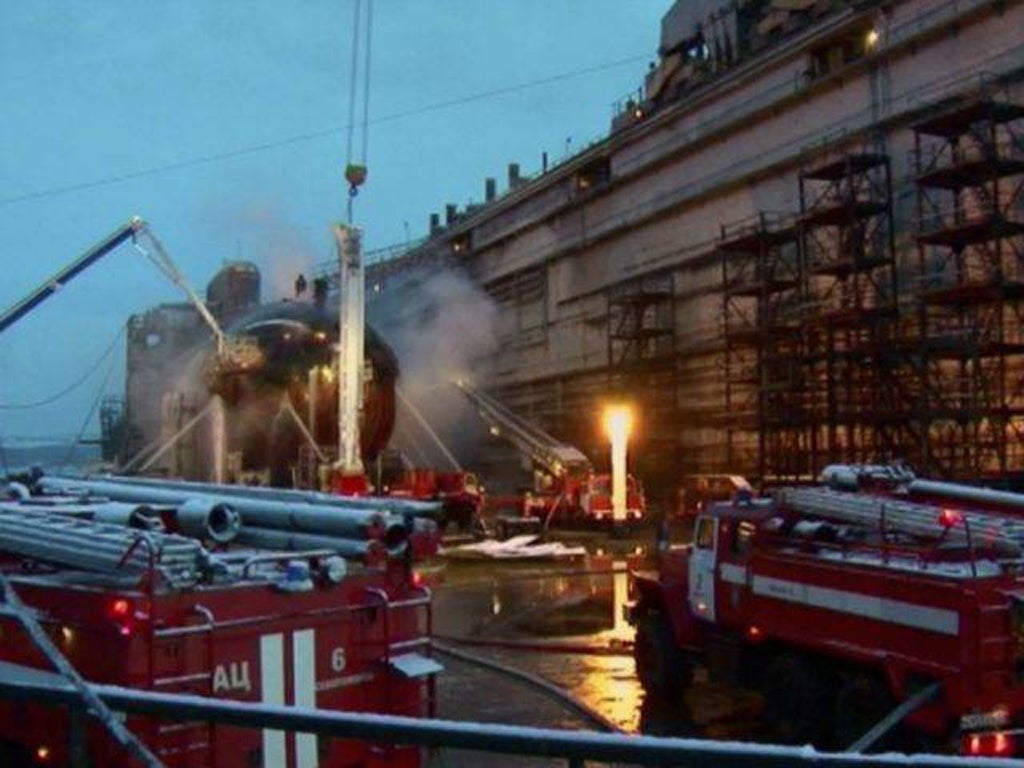Russia nuclear submarine fire put out

Firefighters have extinguished a massive fire aboard a docked Russian nuclear submarine as some crew members remain inside, officials say.
There was no radiation leak and the vessel's nuclear-tipped missiles were not on board, they said.
Military prosecutors are investigating whether safety regulations were breached.
President Dmitry Medvedev summoned top Cabinet officials to report and demanded punishment for anyone found responsible.
The fire broke out yesterday at an Arctic shipyard outside the north-western Russian city of Murmansk where the submarine Yekaterinburg was in dry-dock.
The blaze, which shot orange flames high into the air through the night, was put out today and firefighters continued to spray the vessel with water, Emergency Situations Minister Sergei Shoigu said.
Russian state television earlier showed the rubber-coated hull of the submarine still smouldering, with firefighters gathering around it and some standing on top to douse it with water.
Most modern submarines' outer hulls are covered with rubber to make them more difficult for an enemy to detect.
Seven members of the crew were taken to hospital after inhaling carbon monoxide fumes from the fire.
An unspecified number of crew remained inside the submarine during the fire, the Defence Ministry said.
A spokesman insisted there never was any danger of it spreading inside the sub and said the crew reported that conditions on board remained normal.
It was unclear whether the crew were trapped there or ordered to stay inside.
Norway's Radiation Protection Authority across the border reported it has not measured any increased radioactivity.
The governor in Finnmark, Norway's north-eastern province that borders Russia, and the radiation agency complained about the Russian response.
"There have been problems to get clear information from the Russian side," said Gunnar Kjoennoey. "We have an agreement to exchange information in such cases, but there has been no information from the Russian side so far."
Russia's military says the blaze started on wooden scaffolding and then engulfed the sub's outer hull. The vessel's nuclear reactor had been shut down and its nuclear-tipped missiles and other weapons had been unloaded before dry-dock repairs, it said.
Toxic fumes from the blaze had spread to the town of Roslyakovo where the shipyard is located, but officials said there was no need to evacuate local residents.
Nikolai Kalistratov, a former director of the biggest shipyard in the area, said the fire was probably caused by the failure to take proper safety precautions, such as coating the scaffolding with special sprays to make it fire-resistant.
The Yekaterinburg is a Delta-IV-class nuclear-powered submarine that normally carries 16 nuclear-tipped intercontinental ballistic missiles. The 166-metre (548-ft) vessel has a displacement of 18,200 tons when submerged.
The chief of the General Staff of the Russian armed forces, Gen Nikolai Makarov, led a team of senior military officials to Roslyakovo to oversee the emergency response.
The Russian navy suffered its worst accident in August 2000, when the Kursk nuclear submarine exploded and sank during naval manoeuvres, killing all 118 crew members aboard.
A 2008 accident at the Nerpa nuclear-powered submarine killed 20 Russian seamen and injured 21 others when its fire-extinguishing system activated in error and spewed suffocating gas.
Join our commenting forum
Join thought-provoking conversations, follow other Independent readers and see their replies
Comments
Bookmark popover
Removed from bookmarks